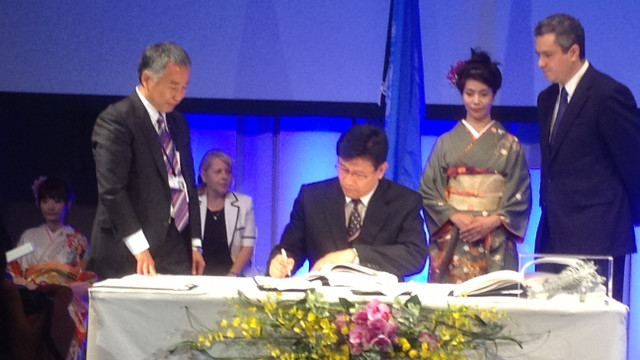
Minamata Convention

On behalf of the Philippine Government, DENR Secretary Ramon J.P. Paje signs the Minamata Convention on Mercury last 11 October 2013 in Kumamoto Prefecture, Japan. (Photo courtesy of DENR-PAO)
Minamata Convention on Mercury is a global treaty to protect human health and the environment from the adverse effects of mercury pollution, including a ban on new mercury mines, the phase-out of existing ones, control measures on air emissions, and the international regulation of the informal sector for artisanal and small-scale gold mining.
The convention is named after Minamata Bay, which was contaminated by methyl mercury discharged from a local chemical factory. The disaster, which affected thousands of human lives was the first large-scale incident of methyl mercury poisoning. Minamata drew the world’s attention to the devastating effects of mercury, a powerful neurotoxicant now known to be particularly dangerous to fetuses, infants, and young children.
The text of the Minamata Convention on Mercury was adopted by the Conference of Plenipotentiaries on 10 October 2013 in Kumamoto, Japan.
The convention is named after Minamata Bay, which was contaminated by methyl mercury discharged from a local chemical factory. The disaster, which affected thousands of human lives was the first large-scale incident of methyl mercury poisoning. Minamata drew the world’s attention to the devastating effects of mercury, a powerful neurotoxicant now known to be particularly dangerous to fetuses, infants, and young children.
The text of the Minamata Convention on Mercury was adopted by the Conference of Plenipotentiaries on 10 October 2013 in Kumamoto, Japan.
- Focal Office:
- Environmental Management Bureau (EMB)
- Date Ratified:
- Signed on October 10, 2013
- Commitments:
- The next step for the Philippines, through the Environmental Management Bureau, is to deliberate on the ratification of the Convention through the preparation of the Ratification Dossier on the Convention. The Ratification Dossier provides the overview of the current state of the Philippines on mercury pollution (including existing laws and policies for control and regulation) and the socio-economic and environmental impacts of the convention. It also includes initial national action plans and strategies for compliance with the Convention.
Under the provisions of the Minamata Convention, Governments (Parties) have agreed on a range of mercury-containing products whose production, import and export will be banned by 2020. These items include:
*Batteries, except for "button cell" batteries used in implantable medical devices
*Switches and relays
*Some compact fluorescent lamps
*Mercury in cold cathode flourescent and external electrode flourescent lamps.
*Soaps and Cosmetics (mercury is used in skin-whitening products)
*Some mercury-containing medical items such as thermometers and blood pressure devices
Pinpointing populations at risk, boosting medical care and better training of health-care professionals in identifying and treating mercury-related effects will all result from adherence to the obligations on the new treaty. - Status / Updates:
- The Environmental Management Bureau, together with the United Nations Training and Research (UNITAR) has prepared the Ratification Dossier for the Philippines. The Ratification Dossier is currently on its final draft, waiting for a certificate of concurrence from the Department of Trade and Industry (DTI), Department of Energy (DOE), and the Occupational Health and Safety Center of the Department of Labor and Employment (OHSC-DOLE).
Future Meeting: Regional Consultations in Preparation for the seventh session of the Intergovernmental Negotiating Committee on Mercury (INC7) to be held in the Dead Sea Area in Jordan, 10-15 March, 2016. - Policy Issuances:
- DENR Administrative Order No. 97-38
- Sources / Relevant Links:
This Page was updated on Wednesday, 13 January 2016 18:24



